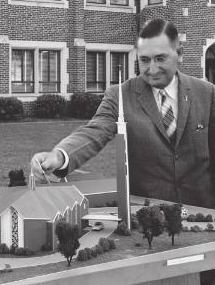Occupation Architect | Name Harold Wagoner Died April 23, 1986 | |
 | ||
Born February 27, 1905 ( 1905-02-27 ) Pittsburgh, Pennsylvania Parent(s) Jessie L. and Harriet Hess Wagoner Awards Award of Merit, Carnegie Institute of Technology; Church Architecture Guild of America Practice Harold E. Wagoner and Associates Buildings United States Air Force Academy Cadet Chapel interior, Coral Ridge Presbyterian Church, National Presbyterian Church, Cathedral of the Rockies Alma mater | ||
Harold Eugene Wagoner (February 27, 1905 – April 23, 1986) was a prominent twentieth-century American ecclesiastical architect who designed many notable churches, including Coral Ridge Presbyterian and National Presbyterian, as well as helping design the interior of the United States Air Force Academy Cadet Chapel. His firm was entirely devoted to ecclesiastical work and had more than 500 commissions in 36 states. He was an instructor in architecture at the Drexel Institute of Technology for more than twenty years.
Contents
Biography
Wagoner was born in Pittsburgh, Pennsylvania to Harriet and Jesse Wagoner and earned a degree in architecture from the Carnegie Institute of Technology, now Carnegie Mellon University. Immediately after graduation in 1926 he went to work for the Methodist Bureau of Architecture where he would continue until its demise in 1933, during the Great Depression. In that year he went to Fontainebleau to study at the École Americaine des Beaux-Arts. After his time in France he moved to Philadelphia where he was associated with the firm of Thomas & Martin followed by Wenner & Chance. From 1942 to 1944, during World War II, he served as Chief of the Camouflage Unit, U.S. Army Engineers.
In 1944 he formed the firm Thomas & Wagoner with Walter Thomas, with whom he'd previously worked, After Thomas's death in 1948, Wagoner formed Wagoner and Associates, which continued into the 1980s. In 1948, he was given the Award of Merit by his alma mater, the Carnegie Institute, and during the 1950s and 60s he dominated the awards of the Church Architecture Guild of America. Wagoner was vice-president of the Philadelphia Chapter of the AIA and also served as chairman of the Commission on Architecture, Lutheran Society of Music, Worship and the Arts and President of the Church Architectural Guild of America. He was succeeded in his firm by Henry Jung.
Style
Wagoner, a Presbyterian, was among the most notable architects of Protestant churches in mid-twentieth century America, with a reputation and impact that few could match. He first received accolades for his designs for First Presbyterian of Vero Beach and St. Paul's Evangelical Lutheran in Savannah, with the later being called, "one of the truly great churches of the South." Some of his commissions were more modest, such as First Baptist in Levittown, but his work was primarily on the high-end for wealthier congregations.
In contrast to Frank Lloyd Wright, the most prominent architect of the time, Wagoner was quite attuned to client wishes. Where Wright would create "client proof" buildings intended to fulfill his own original vision rather than any desire of the customer, Wagoner's hallmark was adapting to congregational needs and desires. If the congregation wished a Colonial Revival church, as with Trinity Presbyterian in Montgomery, then that is what he deliver. If they wished something modern, such as at Wesley United Methodist in Urbana, then he would create a modern design. His work is thus quite eclectic, ranging from the Indiana Limestone-clad First Presbyterian in South Bend, to the very modern glass and concrete Second Presbyterian, and towering Coral Ridge Presbyterian, in Fort Lauderdale. His design for Community Methodist Church in Westwood, Los Angeles used so much concrete that Civil Defense authorities declared it the most Atom bomb proof building in the city.
Wagoner himself worried privately to his friends that he was merely a competent architect rather than a great one. Vincent Kling said of Wagoner that:
No two buildings are alike which, in my opinion, is a great asset. He has always been able to select the architectural mood which is most suited to the environment of the community in which he works. When the site and the sponsorship suggested a very dramatic building, Mr. Wagoner has risen to the occasion and produced good architecture. On the other hand, when the established community and its sponsorship suggested a modest building in character with the neighborhood, Mr. Wagoner again was sensitive to the situation and produced good architecture.
Select works
Rand Chapel of Central Presbyterian Church, Atlanta, Georgia, Early English Gothic Revival style (1949)
Sources:
